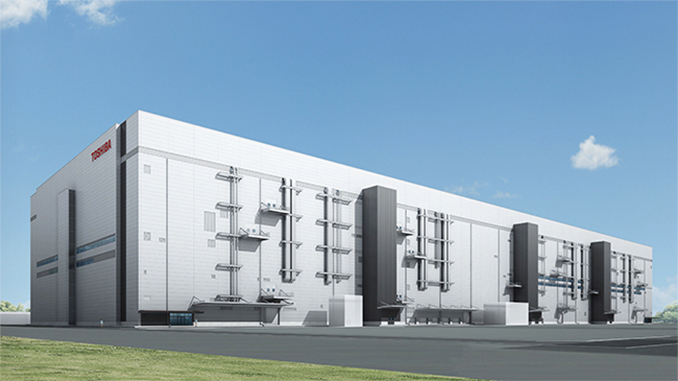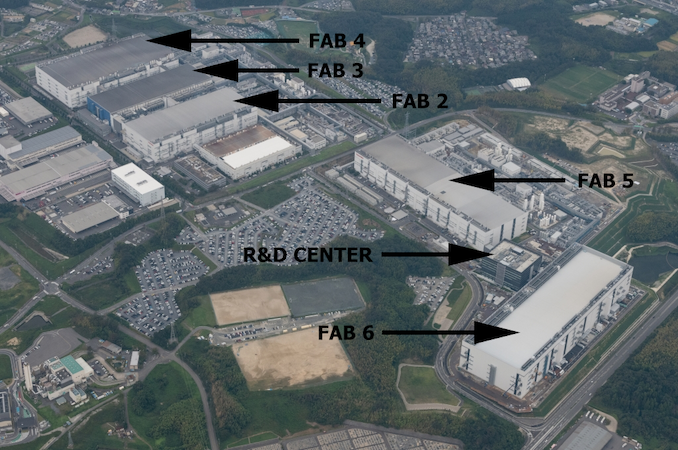Toshiba & WD NAND Production Hit By Power Outage: 6 Exabytes Lost
by Anton Shilov on June 28, 2019 12:15 PM EST
Toshiba Memory and Western Digital on Friday disclosed that an unexpected power outage in the Yokkaichi province in Japan on June 15 affected the manufacturing facilities that are jointly operated. Right now, production facilities are partially halted and they are expected to resume operations only by mid-July.
Western Digital says that the 13-minute power outage impacted wafers that were processed, the facilities, and production equipment. The company indicates that the incident will reduce its NAND flash wafer supply in Q3 by approximately 6 EB (exabytes), which is believed to be about a half of the company’s quarterly supply of NAND. Toshiba does not disclose the impact the outage will have on its NAND wafer supply in the coming months, but confirms that the fabs are partially suspended at the moment. Keeping in mind that Toshiba generally uses more capacity of the fabs than WD, the impact on its supply could be significantly higher than 6 EB with some estimating that it could be as high as ~9 EB.
Both companies are assessing the damage at the moment, so the financial harm of the incident is unclear. Not even counting potential damage to production tools and other equipment used at the fabs, 6 EB of NAND cost a lot of money. Furthermore, analysts from TrendForce believe that a consequence of the outage will be some loss of confidence from clients of both companies, which will have a financial impact as well.
The Yokkaichi Operations campus jointly owned and run by Toshiba and Western Digital produces about 35% of the global NAND output in terms of revenue, according to TrendForce. At present, the manufacturing base has five production facilities (Fab 2, Fab 3, Fab 4, Fab 5, and Fab 6) as well as an R&D center, all of which were affected by the outage. Three fabs within the campus produce 3D NAND flash, whereas another two are used to make special-purpose types of memory.
Considering the gargantuan size of the Yokkaichi Operations, disruptions of its supply will inevitably have an effect on 2D NAND and 3D NAND spot prices in the short-term future. Nonetheless, since contract prices have already been set for Q3 (and possibly Q4), they are not going to change. Meanwhile, it remains to be seen whether large customers will have to go shopping in Q3 or Q4 and affect prices on the spot markets further.
Considering that the Yokkaichi Operations produces at least 1/3 of the global NAND flash output (let’s assume that dollar share more or less corresponds to bit share) and half of its production for the quarter was lost because of the incident, this means that the industry will miss approximately 1/6 (or 16.5%) of the global NAND supply in Q3. Whether or not this will create a deficit on the market that will cause significant price hikes depends on multiple factors and is something that remains to be seen.
Related Reading
- Toshiba Memory and Western Digital Open Fab 6 and New Memory R&D Center
- Toshiba Memory & Western Digital Finalize Fab K1 Investment Agreement
- Toshiba Begins to Construct New BiCS 3D NAND Fab in Iwate Prefecture
- Toshiba Memory to Build New Fab to Produce BiCS 3D NAND
- Toshiba Finalizes Plans for New 3D NAND Fab: Coming Online in 2019
- Toshiba to Build New Fab to Produce BiCS NAND Flash
Sources: Western Digital, Reuters, TrendForce, Blocks & Files












148 Comments
View All Comments
evernessince - Tuesday, July 2, 2019 - link
@SantovolOh please, "super speedy batteries"? I've got battery backup for my house and the lights don't even flicker when the power goes out. Heaven forbid a billion dollar facility can't do that.
FunBunny2 - Tuesday, July 2, 2019 - link
"I've got battery backup for my house and the lights don't even flicker when the power goes out."that's because, if you have an APC like mine, it's in line all the time, is connected to the PC, which means each and every machine in each building has to have a very scaled up APC. and each machine needs sufficient intelligence to be monitored by the APC controller to do that.
rrinker - Friday, June 28, 2019 - link
Hell 25+ years ago the large mainframe datacenter I worked in had no chance that batteries could sustain the processors, DASD, and more importantly, the chillers. A huge room full of batteries was just enough to keep it going for the THREE generators to fire up. Any 2 generators could sustain the load, the third was a backup. These were sort of medium size generators - the sort of diesels you might find in heavy construction equipment (slightly larger than semi truck types). Around the same time I also got to tour a major telecom interconnect site - they too had a huge room full of batteries to allow their generators to start - their generators used diesels the size of locomotive prime movers.Santoval - Saturday, June 29, 2019 - link
So the batteries did not provide them enough time to shut down anything "gracefully"? Why have batteries at all then, if they are good for nothing? Or did the batteries provide them enough power to shut down just the most critical systems, and the rest had to be left out?GreenReaper - Sunday, June 30, 2019 - link
To keep things going until the generators start up. They can keep going as long as there's fuel.imaheadcase - Friday, June 28, 2019 - link
Yes he is serious. Most companies don't have enough standby power for full operations, just for critical things. Considering this is a plant, critical is not full operations. I can tell for a fact that its easier to claim loss than worry about it. Case in point, a normal walmart does $100million a year..but only power emergency lights, servers for registers and cameras. Thats it. The back up power sits in a small closet. Freezers, coolers, etc are not powered at all.evernessince - Tuesday, July 2, 2019 - link
Walmart does not loose half it's product if the power goes out. Your comparison makes zero sense.Acreo_Aeneas - Sunday, June 30, 2019 - link
Actually, most fabs cost somewhere in the ballpark of $3-5 billion. A typical first-world aircraft carrier of a modern navy costs $6-9 billion.In comparison, the latest Gerald Ford US aircraft carrier is estimated to cost about $9 billion. While the Fab15 facility of TSMC was estimated to cost $9.3 billion.
Given that, perhaps they are more close to parity in terms of cost, rather than one being far costlier than the other.
As for backup power, it's probably not feasible for a fab of this size to have extensive battery/generator backups. Where as, some very modern aircraft carriers may have backup systems in place, but they are only meant for short periods and at minimal operating capacity (probably emergency lighting, basic navigation/systems, and perhaps some weaponry).
Backup systems for a mutli-facility fab like this probably would be very expensive to maintain and operate. Even if it did exist and work properly, I doubt it would hold out for 13 minutes. Most larger server facilities that have backup systems are designed to let the facility fail gracefully (basically enough time to save and power down, not run for hours on end until power is restored). Even, these larger server farms probably would still crash and fail if they ever had to rely on their backup power systems.
FunBunny2 - Sunday, June 30, 2019 - link
" Where as, some very modern aircraft carriers may have backup systems in place, but they are only meant for short periods and at minimal operating capacity"considering that such boats are run by pressurized light water nucular reactors, how much of the boat still runs if that reactor goes legs up is the least of your problems. :)
jhh - Monday, July 1, 2019 - link
US Aircraft carriers have two nuclear reactors, and a single reactor is sufficient to keep the ship moving fast enough to deploy and retrieve aircraft, although deployment is slower - perhaps only one launch at once, and perhaps a lower payload on the aircraft since the ship isn't able to move at full speed. But a stopped aircraft carrier is likely to become a sunk aircraft carrier.A set of generators at my office stores two weeks of fuel for the diesel generators, and has contracts in place to deliver a full load of fuel on a day's notice. One of the two generators is sufficient to operate the facility, but one isn't enough to start the chillers which cool the facility while the load of the facility is on the generator, so if there is a generator failure on startup, and the chillers aren't started before the batteries run out, the data center is likely to overheat.
In a huge site like this one, there are bound to be generator failures, and the maintenance staff is not likely to be in the right place to change jumpers and get all the equipment not on UPS moved quickly. Chillers and motors have a large (but short) load on startup, and don't work well with UPS equipment, they need the momentum of a mechanical generator to get over the short large load.